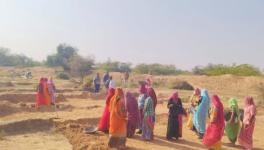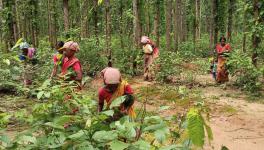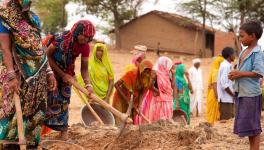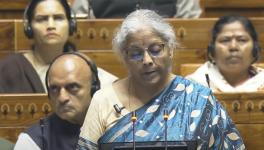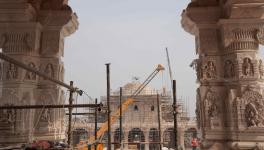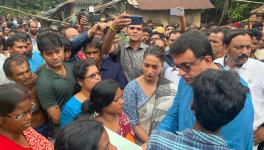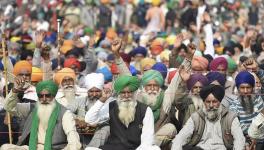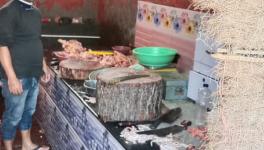Ground Report: ‘Adarsh Ponds’ Thirsty for Water in Some Villages of UP
A visit to some villages near Lucknow to take stock of the condition of ‘model or ‘Adarsh Ponds’ built under MGNREGA (rural job guarantee scheme) under the Adarsh Reservoir Scheme for the purpose of water harvesting, tells a story that’s anything but ‘model’.
In this scorching heat, some ponds were parched, while some others were full of moss and dirt with a little bit of water, which was clearly not fit for human or animal consumption.
It is obvious that apart from the rains, the ponds will not fill up themselves. These will have to be filled up. But, till now no effort seems to have been made in this direction. If these ponds had water, these would have been of great use to not only villagers but also animals and birds, as also stray animals in this scorching heat.
It may be recalled that Uttar Pradesh Chief Minister Yogi Adityanath, while expressing concern over the depleting groundwater level, had announced the Adarsh Talab Yojna about four years ago. The objective was to conserve groundwater and make quality water available to the people. Officers were given orders to ensure jobs under MGNREGA were created to dig new ponds and renovate the old ones.
One of the purposes of these ponds was also to harvest rainwater. Under this scheme, there were plans to plant trees around the Adarsh Ponds, beautify the surrounding area, install benches etc. But, all the ponds visited by this reporter in different villages were nowhere close to the desired objectives. Some ponds looked pathetic with either no water, or covered with moss or water hyacinths.
The first village we visited was Sonwa, under Indorebagh Tehsil, located in Bakshi Ka Talab (BKT), a rural area of Lucknow. A special purpose of visiting this village was also that a team of top officials from the Prime Minister's Office had recently visited Sonwa to inspect the Adarsh Pond, and while praising these ‘model ponds’, they had talked about digging more such ponds under MGNREGA.
On our way to Sonwa, we saw Dehuva and Imliha ponds outside the village, which were dug under the Adarsh pond scheme. The thick bold letters explaining the idea behind these ponds, embossed on the stones laid there, were still shining, but the ponds were looking lifeless.
These ‘model’ ponds were without water, there was dirt all around, wild bushes had grown, the stairs leading to these ponds had started crumbling with grass growing on them. The Imliha pond was filled with water hyacinths.
When we went inside the village, we met Sunita Devi, a MGNREGA worker, who also worked under the Adarsh Talab Yojana.
“If you want to see water in the ponds, come during the rainy season, the rest of the time there is not a drop of water in these ponds,” she said.
"In this scorching heat, when there is a need for water for humans and cattle, these ponds are dry. What use are these ponds for us?" said Sunita Devi, adding that they keep asking this question to the administration, but yet these ponds are not being filled up.
She further told us that whenever MGNREGA work starts in the village, she definitely works in it, although she never gets paid on time. When the team of high officials came to her village, they said many things for the benefit of villagers, including assurances that MGNREGA payments would be on time. But nothing has improved.
After Sonwa village, we reached Mishripur village. There, too, the condition of the Adarsh pond was bad. There was little water in the pond, which was covered with moss and dirt. It was by no means fit for drinking, even for cattle. A pile of garbage lay around the pond.
We spotted two children who were digging the soil on the bank of the pond and carrying it away. On being asked, they told us that this soil would be used for domestic work.
We then left for Asti village, where we met Savitri. Sitting in one of the rooms of her house, she was busy weaving straws. She belongs to a very poor family of nine members, which includes four sons, two daughters, a daughter-in-law, and her husband.
Savitri told us that due to poverty, her children could not be educated much, and now all the sons work as laborers. Her husband is also a labourer and she does MGNREGA work and farm labour.
Due to not having their own land, she works as an agricultural labourer in the fields of others, and whenever the MGNREGA scheme starts in the village, she also works in it.
“Even under MNREGA, now there is not much work left. Where else can I get employment from?” she asks us in a sad tone.
Savitri tells us that about two years ago, when the work of constructing a pond under MGNREGA started outside her village under the Adarsh Talab Yojna, she worked there. When asked how beneficial the pond was for the villagers, she said: “Let me show you that pond, see its condition for yourself.”
Although Savitri's reply had given us a hint of the actual condition of the pond, we set out to take stock of its condition.
There was not a drop of water in the ‘model’ pond. Savitri said it took hard labour of MGNREGA workers and machines to build the reservoir, but it exists only in name.
“Only a big pit of soil remains as it was never given the shape of a pond,” said Savitri, adding that “a little water fills up during the rainy season, but due to the soil and mud, the water is not fit for drinking even for animals.
While talking to Savitri, we saw a woman carrying a basket full of soil from the dug pond. She told us that she is taking the soil to paste it on her home walls and her mud stove. “To be honest, this is the only use of this pond,” added Savitri.
Savitri said there was another pond in her village which was full of water but was of no use to villagers, their livestock or stray animals. This is because that pond has been given on contract for fish farming whereas it was constructed for the benefit of villagers and livestock.
After leaving Asti village, we reached Barakhempur village. MGNREGA labourer Jugraj, who lives in this village, said that the ponds that were dug years ago, were dug again under MGNREGA. “Some have water in them, some remain dry,” he said, adding that the “Adarsh pond scheme is a good scheme, but if there is no water in the ponds, what’s the use of building a pond.”
We then proceeded to the neighboring village of Shivpuri. On the way, we saw a pond which was very big and was full of water, but here, too, its condition was similar. The water was completely green because it was covered by moss. Clearly, it had not been cleaned for a long time.
Some villagers passing by told us the pond is always filled with moss, due to which there is no use of its water. Instead, insects, mosquitoes flourish in the dirty water causing health hazards for villagers.
When we reached the last village, Shivpuri, the villagers told us that the Adarsh pond scheme had not reached their village yet. They said they were eagerly waiting for it as they would at least get some work under MGNREGA.
Inder, a resident of this village, said: “The condition of the Adarsh ponds is not ‘ideal’ in any respect. The ponds are dry and are not being filled. In this summer heat, especially stray cattle are troubled by the scarcity of water. Despite this, the villagers are waiting for the scheme to reach here as it will get them some kind of employment.
In sum, the ground reality is that these ‘model’ or Adarsh Ponds were dug, in some places trees have been planted around the ponds, benches have been put up in some places, there are gates and eve stairs in some of them, but there is lack of maintenance and there is no water in them, even in this scorching heat.
Cattle go till the pond but return thirsty. Overall, it would not be wrong to say that due to the lack of water, these reservoirs themselves are thirsty.
The writer is an independent journalist.
(Translated from Hindi by Aditi Nigam)
Get the latest reports & analysis with people's perspective on Protests, movements & deep analytical videos, discussions of the current affairs in your Telegram app. Subscribe to NewsClick's Telegram channel & get Real-Time updates on stories, as they get published on our website.










